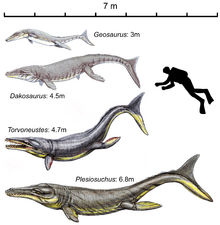Geosaurinae
Geosaurinae is a subfamily of metriorhynchid crocodyliforms from the Middle Jurassic to the Early Cretaceous (Bajocian - Valanginian) of Europe, North America and South America.[1][2] Named by Richard Lydekker, in 1889, it contains the metriorhynchids Suchodus, Purranisaurus, Neptunidraco, Tyrannoneustes, Torvoneustes, Dakosaurus, Geosaurus and Plesiosuchus. The last four taxa form a tribe within Geosaurinae, the Geosaurini. Geosaurinae is one of two subfamilies of Metriorhynchidae, the other being Metriorhynchinae.[3]
| Geosaurines | |
|---|---|
| Dakosaurus maximus skull, Staatliches Museum für Naturkunde Stuttgart | |
| Scientific classification | |
| Kingdom: | Animalia |
| Phylum: | Chordata |
| Class: | Reptilia |
| Suborder: | †Thalattosuchia |
| Family: | †Metriorhynchidae |
| Subfamily: | †Geosaurinae Lydekker, 1889 |
| Genera | |
| |
Phylogeny

Geosaurinae is a stem-based taxon defined in 2009 as the most inclusive clade consisting of Geosaurus giganteus, but not Metriorhynchus geoffroyii.[1] Geosaurini was named by Lydekker in 1889, and it is a node-based taxon defined by Andrea Cau and Federico Fanti in 2011 as the least inclusive clade consisting of Geosaurus giganteus, Dakosaurus maximus and Torvoneustes carpenteri. The cladogram below follows the topology from a 2011 analysis by Young et al.[4]
| Geosaurinae |
| |||||||||||||||||||||||||||||||||||||||||||||||||||||||||||||||||||||||||||||||||
References
- Mark T. Young and Marco Brandalise de Andrade (2009). "What is Geosaurus? Redescription of Geosaurus giganteus (Thalattosuchia: Metriorhynchidae) from the Upper Jurassic of Bayern, Germany". Zoological Journal of the Linnean Society. 157 (3): 551–585. doi:10.1111/j.1096-3642.2009.00536.x.CS1 maint: uses authors parameter (link)
- Mark T. Young, Stephen L. Brusatte, Marcello Ruta and Marco Brandalise de Andrade (2010). "The evolution of Metriorhynchoidea (Mesoeucrocodylia, Thalattosuchia): an integrated approach using geometrics morphometrics, analysis of disparity and biomechanics". Zoological Journal of the Linnean Society. 158 (4): 801–859. doi:10.1111/j.1096-3642.2009.00571.x.CS1 maint: uses authors parameter (link)
- Andrea Cau; Federico Fanti (2011). "The oldest known metriorhynchid crocodylian from the Middle Jurassic of North-eastern Italy: Neptunidraco ammoniticus gen. et sp. nov". Gondwana Research. 19 (2): 550–565. doi:10.1016/j.gr.2010.07.007.CS1 maint: uses authors parameter (link)
- Mark T. Young, Mark A. Bell, Marco Brandalise de Andrade and Stephen L. Brusatte (2011). "Body size estimation and evolution in metriorhynchid crocodylomorphs: implications for species diversification and niche partitioning". Zoological Journal of the Linnean Society. 163 (4): 1199–1216. doi:10.1111/j.1096-3642.2011.00734.x.CS1 maint: uses authors parameter (link)